Choosing the installation type
There are two main types of dishwasher installation: built-in and stand-alone. Let’s look at each of them in more detail.
Built-in
The most popular installation type among buyers. This type of machine is installed under the countertop. It does not require a special cabinet. It can be installed between two cabinets, as it does not require side and top panels. The door of the built-in dishwasher can be hidden behind the front door of the kitchen facade. This gives the kitchen a uniform, beautiful look. Fully built-in appliances can easily fit into any kitchen.
For partially built-in models, the control display is usually located on the outer door. Therefore, the dishwasher door is not hidden behind the kitchen unit facade, but remains outside.
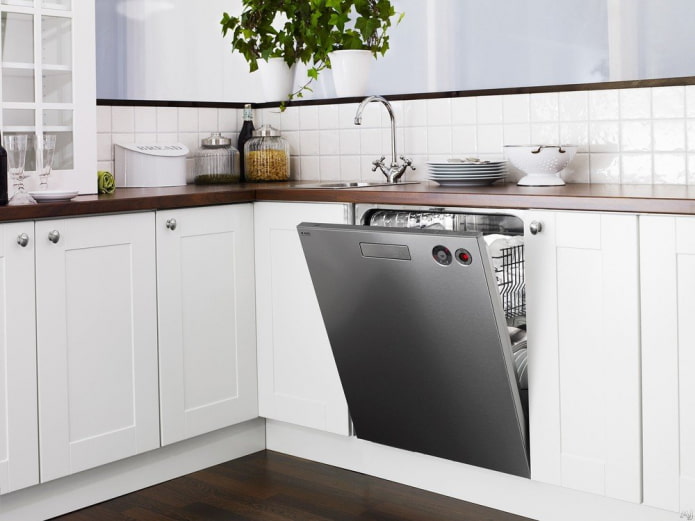
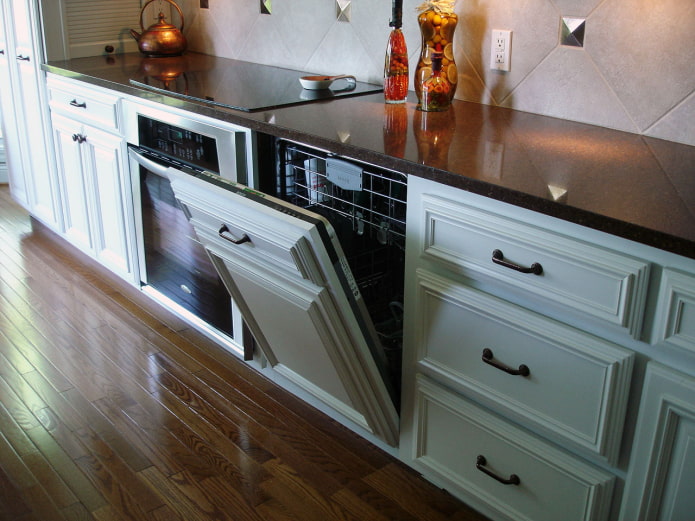
Autonomous
This is a freestanding dishwasher that comes with a removable lid. It is suitable for those who do not have or do not have space under the countertop. It can be placed in a convenient place in the kitchen. However, thanks to the removable lid, it can be placed under the countertop. At the same time, it does not require the installation of a front facade that matches your cabinets.
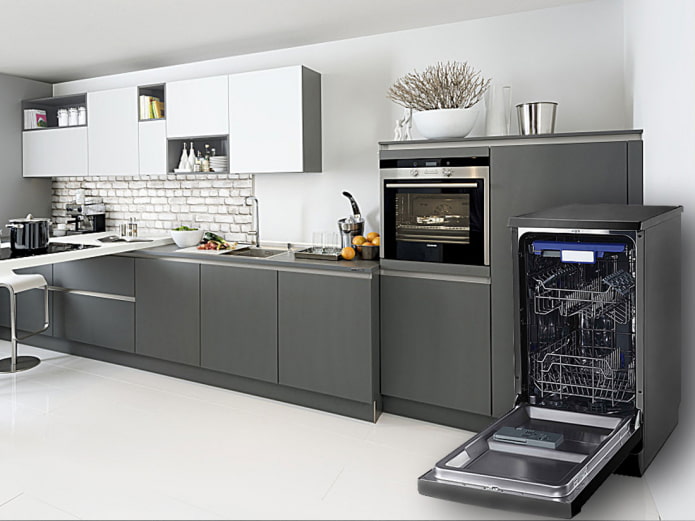
What size should I choose?
A common factor to consider when buying a dishwasher is size. This parameter determines the internal capacity of the chamber and how many dishes the dishwasher can wash at one time. Dishwashers are sold in several sizes. Each size is suitable for a certain family composition.
Full-size
If the family is large (more than 4 people), guests often come and there are a lot of dishes, then the best option would be a full-size dishwasher. The capacity of the box allows you to fit up to 12 sets of dishes. It has the following dimensions: width 60 cm, depth 60 cm and height 85 cm. These dimensions are standard for all manufacturers.
The main thing is to make sure before buying that such a machine fits under your countertop. Water consumption for maximum load is 12 liters.
Narrow
A narrow dishwasher is suitable for a small kitchen or for a family of three. It is the same height as a full-size one, only its width is about 45 cm. Capacity – 9-10 sets of dishes. Water consumption for a full load is 9-10 liters.
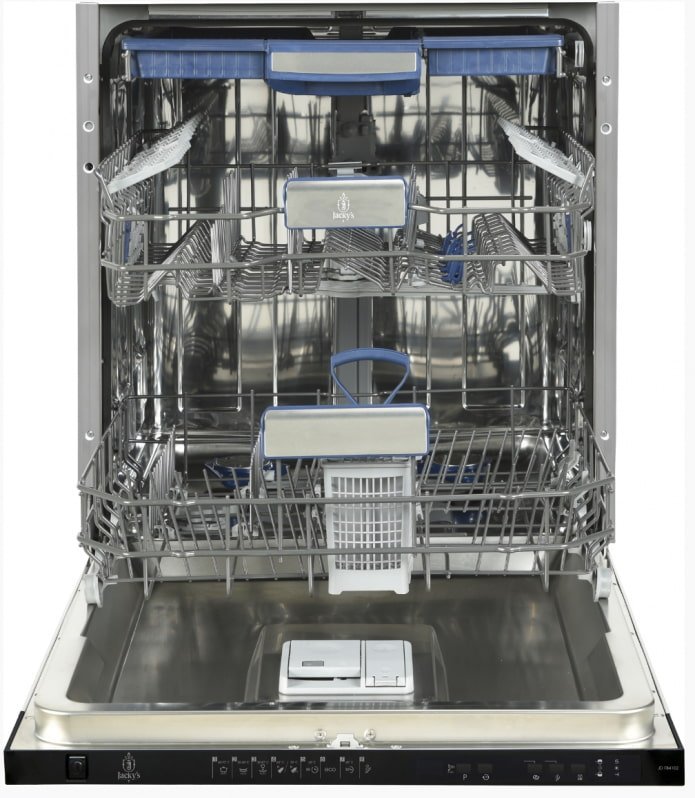
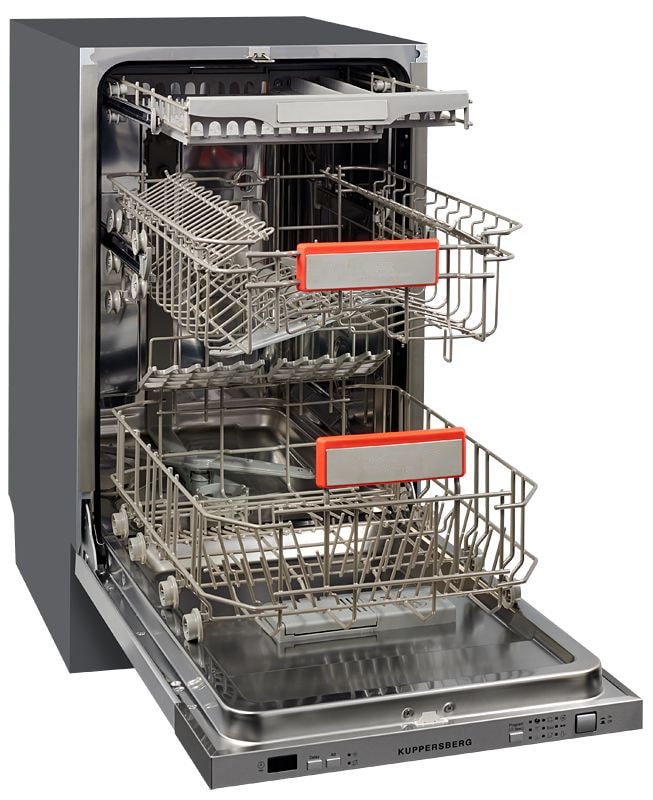
Compact
If your family is not large or you cook little, then buying a large full-size dishwasher does not make sense. There are many compact dishwashers on the market. Their height is about 44 cm. This is almost two times less than that of full-size ones. Depth – 50 cm, width – 55 cm, also slightly smaller than standard sizes. Capacity – up to 6 sets of dishes. Water consumption for a full load – 5-6 liters.
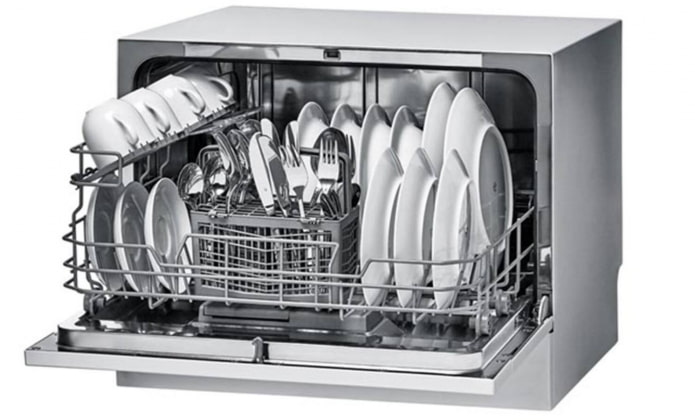
Features of the internal filling
The internal filling of the dishwasher depends on the model and manufacturer. For example, not all models can accommodate very large plates. Therefore, before buying, you need to make sure in advance that your plates will fit.
Pay attention to the following features of the internal contents.
Compact models of dishwashers consist of one basket, which also includes a tray for cutlery.
Other models: full-size or narrow can have two or three tiers, depending on the model. They allow you to wash a lot of dishes in one load.
Models with three baskets
Features of the contents – different compartments for dishes and cutlery. The third pull-out tier is a separate tray for cutlery, where forks, knives and spoons are placed horizontally. This option is safer than a tray, since there is no risk of accidentally cutting yourself with a knife when unloading.
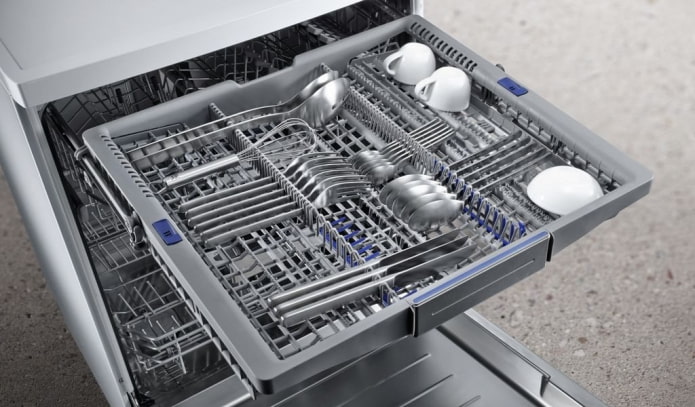
The middle basket in such models is usually height-adjustable. The adjustment provides versatility and the ability to adjust the height to suit your needs. It can also be removed altogether if necessary to wash something large and complex. For example, oven racks and baking sheets. The lower and middle baskets are very roomy.
Models with two baskets
Features of filling – the cutlery tray is on the lower tier. The lower basket is designed to accommodate larger dishes: pots, pans, plates. There are holders that allow you to evenly arrange the plates.
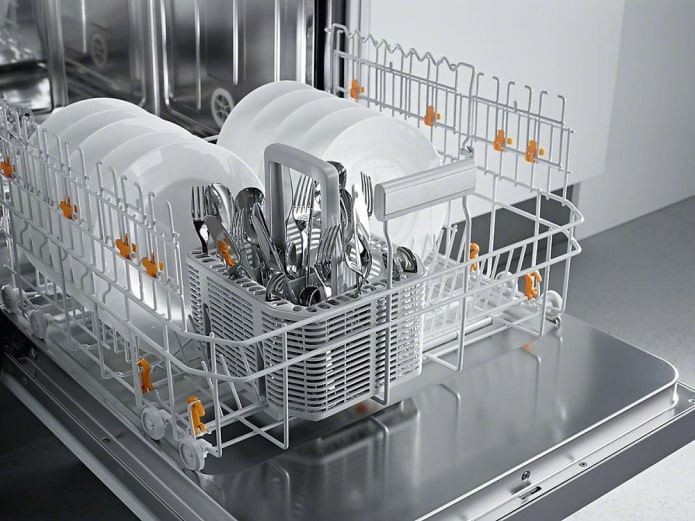
The upper basket is designed for small utensils: cups, glasses, goblets, saucers, etc.
Plastic dishes should also be on the top shelf, away from heating elements. The upper basket in some models changes its position, that is, it is height-adjustable.
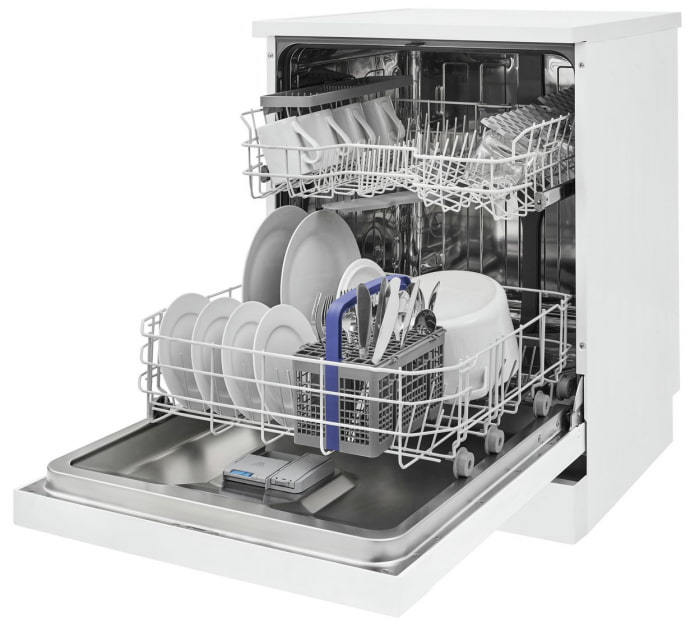
What is the acceptable wash quality?
If your dishwasher does not wash dishes effectively, then the other additional functions are no longer of great importance. The wash quality is determined by how clean the dishes are after the end of the cycle. Dishwashers are divided into classes according to this scale. You can find dishwashers of class A, B and C on sale.
- Class A provides high quality dishwashing. To achieve the best results, choose these models. They are usually equipped with several sprayers and active drying technology. There are usually three sprayers. The lower one is usually a “rocker” with holes, from which water is supplied under pressure.
- Class B provides average quality of dishwashing. Such dishwashers can also wash dishes well without any visible dirt. Sometimes it is impossible to distinguish the difference in the cleanliness of dishes washed in a class A and B machine with the ordinary human eye.
- Class C provides basic quality of dishwashing. Such dishwashers have a minimum set of bells and whistles and after the cycle is completed, dirt may remain on the dishes.
Which dishwasher is more economical?
More and more consumers are paying attention to the energy efficiency class when choosing household appliances. For dishwashers, the energy efficiency class starts from A+++ as the most efficient and ends with D as the least efficient.
On the label of the dishwasher, you can see the energy efficiency class and how many kilowatt hours the machine consumes per wash cycle.
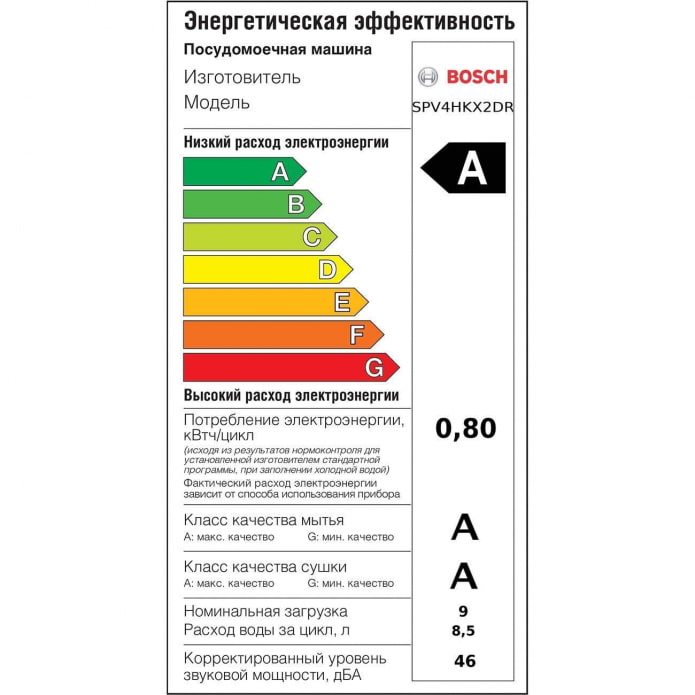
By multiplying this number by the cost of kWh of electricity in your region, you get the cost of one cycle. If you use the machine every day, then multiply this number by 365 and then you will find out how much money you will pay for electricity per year of washing.
For example, a dishwasher has an energy efficiency class A++ and consumes 0.74 kW h per washing cycle. The price of energy in your region is 4.5 rubles per 1 kW h. The cost of one cycle is 0.74 * 4.5 = 3.33 rubles. In a year, you will spend 1215.45 rubles.
By choosing energy-efficient models (A+++, A++ or A+), you will be able to save on your electricity bill.
To further reduce energy consumption, the dishwasher can be connected not only to a cold water supply, but also to a hot one. Only the water temperature should not exceed 60 degrees.
You can also see the water consumption on the label. The number under the tap indicates how many liters the machine consumes per dishwashing cycle. Using the example of calculating electrical energy, you can calculate how much money you will spend on water per year. It’s not difficult. Hand washing dishes requires more water than a dishwasher.
What do you need to know about leak protection?
Leak protection is a useful feature that many modern dishwashers are equipped with. There are two types of protection for dishwashers: full or partial.
Partial
Protects only the body. There is a tray with a float under the device. The float is equipped with an electronic humidity sensor. If there is a leak, the dishwasher will report an error, cancel the washing program and pump out the remaining water from the body.
Full
A newer protection technology is much more reliable than partial. In addition to the tray with a float, the machine is equipped with an inlet hose with an electric valve. In the event of a leak, the sensor closes the electric valve and the water supply to the machine stops. Models with full leak protection are not cheap. However, repairs in case of potential flooding will cost more.
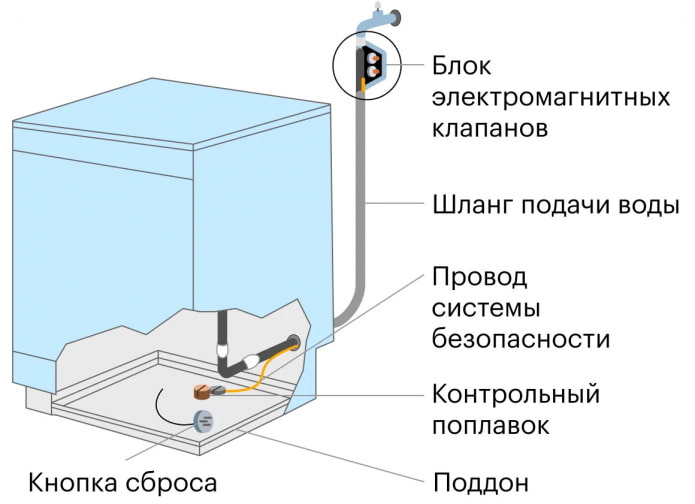
Technical characteristics that are worth considering
Let’s look at the technical characteristics of the dishwasher that are worth considering. They can be called useful and give priority to them if they are necessary.
The delayed start function is very convenient. It is available on many models and holds the start time of the program. The timer delay time depends on the model. Most models allow you to hold the start of the program for up to 8 hours, some models – up to 12-24 hours. This option allows you to run the machine at night, when the electricity tariff is cheaper.
Salt and rinse aid indicators tell you when it’s time to add salt or rinse aid.
The child lock function is present on many models. It is designed to prevent a child from accidentally interrupting a running cycle or starting a new one.
Dishwashers have a filter that prevents washed-out food residues from getting back onto the dishes. The filter can be manual or self-cleaning. Manual ones need to be cleaned by hand once a month. To reduce clogging of the filter, remove large food remains from dishes before loading them into the dishwasher.
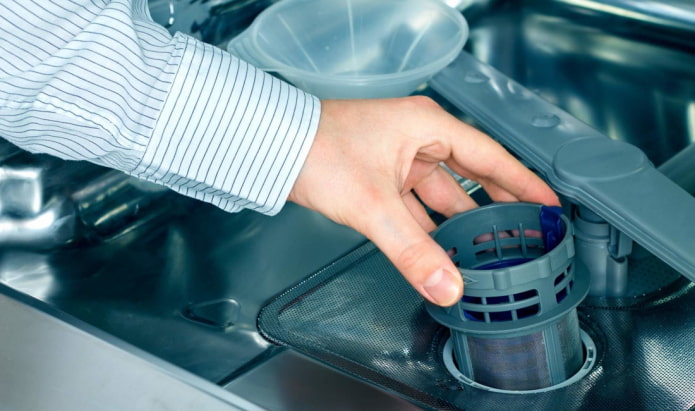
Self-cleaning filters clean themselves. The consumer does not need to think about cleaning. The type of filter in the dishwasher can be found in the user manual.
Pay attention to the presence of a built-in water softener in the dishwasher. It is needed to soften the hardness of the water. It prevents the appearance of streaks and white spots on the dishes. Hard water has an increased content of minerals. The use of hard water leads to the formation of limescale on the dishes. Without a softener, the efficiency of the dishwasher is lost. Hard water leads to scale formation, clogging and rust formation over time.
Many models have a half-load function. In this case, you need to load dishes only in the lower or upper basket. Which basket will be involved depends on the model. Engineers develop such functions to save: money, time and energy.
Important points about drying types
A dishwasher can dry dishes in several ways. There are active or standard drying methods. In total, there are three main methods:
Method 1. Condensation
Condensation drying is the most environmentally friendly, when the dishes dry naturally. At the very end of the cycle, after rinsing the dishes with bitter water, the dishwasher opens the door. This way the moisture evaporates faster.
Sometimes the machine is not equipped with a lever that opens the door automatically. Then the hot steam rises, condenses and settles on the walls of the chamber. This drying takes longer. To reduce the drying time, you can open the door yourself at the end of the washing cycle.
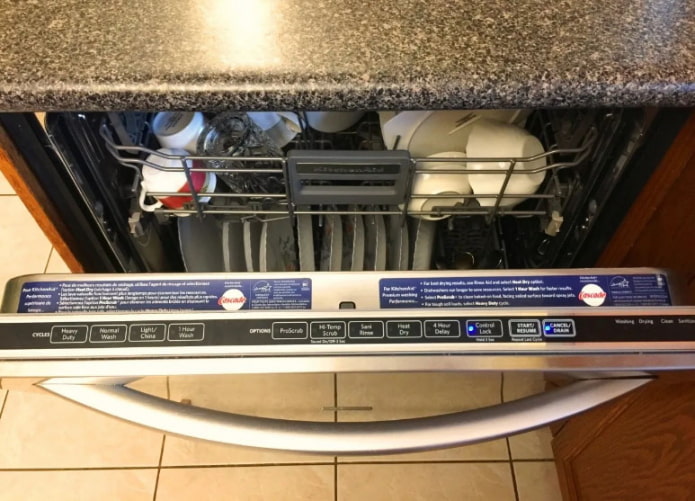
Method 2. Convection
Drying with heated air. Such machines have a heating element and a fan. The heating element heats the air, and the fans ensure the distribution of warm air throughout the chamber. Thanks to turbo drying, the dishes dry evenly on all tiers, and the drying speed increases.
Method 3. Zeolite
There are zeolite granules at the bottom of the dishwasher. Mineral zeolite releases heat when in contact with water. It penetrates into the chamber and dries the dishes. Zeolite granules are restored after each wash. Zeolite drying is the most energy efficient and is found in premium dishwashers.
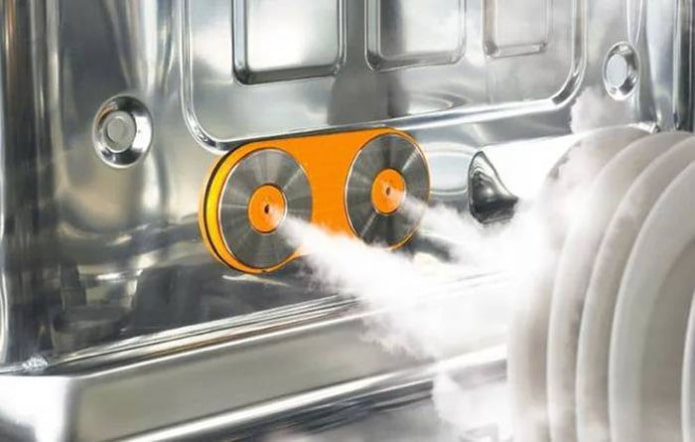
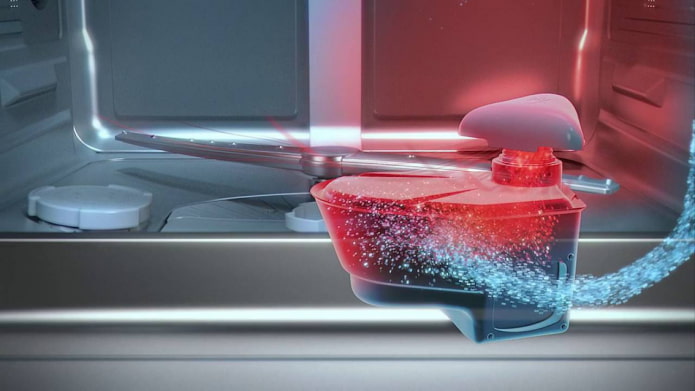
What do you need to know about the noise level?
The characteristics of each dishwasher indicate the noise level during operation in dB. Knowing how to understand the decibel value will help you when choosing a dishwasher. The noise level of dishwashers can be divided into three categories.
- Very quiet – less than 44 dB.
- Moderately quiet – from 44 to 49 dB.
- Noisy – more than 50 dB.
For a standard home environment, equipment belonging to the second category is suitable. Most models fall into this noise range. If the kitchen is located in a separate room, then choose this option. Dishwashers with a noise level of up to 49 dB are great for home use.
If you are sensitive to noise or live in a studio apartment, then you should take a closer look at the first category by noise level. They are not much more expensive, but they work almost silently.
Noisy dishwashers from the third category are quite often produced by manufacturers. Keep in mind that if your bedroom is next to the kitchen, then the dishwasher running overnight can interfere with your sleep with its work. To significantly reduce noise, you can make soundproofing yourself.
Which control is more convenient and the features of different modes
Dishwashers are produced with top and front control. To make it easier for you to decide on the option, let’s look at the features of each of them.
Top control
All the setting buttons are located at the top of the door. When the door is closed, no control buttons are visible. Basically, all built-in models have this design. Thanks to this, it is possible to attach a kitchen front to the dishwasher door. The downside of this type of control is that you can access the controls by opening the door.
The buttons on the control panel can be touch or mechanical. It is easier to maintain a smooth touch panel. Just wipe it with a cloth to remove any grease and dirt.
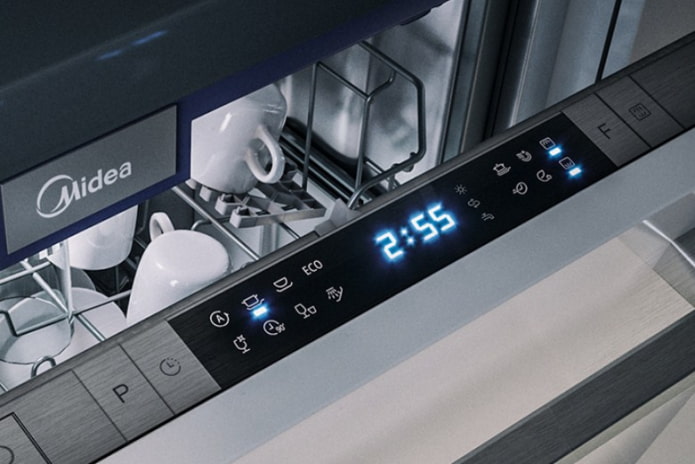
Front control
The control panel is located on the outer door of the dishwasher. This allows you to control the appliance with the door closed. Often the handle is recessed and forms a “pocket”. Models with front control are suitable for almost any design of household appliances in the kitchen. On the downside – there is a risk of accidentally pressing the buttons.

Washing modes depend on the specific model of the dishwasher. You can read all the programs in detail in the operating instructions. Let’s consider the features of the modes that are common to many models.
The normal mode is used for daily regular use. It removes medium dirt. Dishes are usually washed in the temperature range of 50-60 degrees. The cycle lasts on average 2 hours.
The quick mode is used when you need to quickly wash not very dirty dishes. The cycle duration is 40 minutes – 1 hour at t 50 (˚C).
The intensive mode is used for heavily soiled dishes: frying pans, pots, baking sheets. It requires higher temperatures to remove all stains. The cycle lasts 2.5-2.75 hours at a temperature of t 65 (˚C).
The delicate mode is useful for washing fragile glassware and other materials. The utensils are washed for 1.5 hours at t 45 (˚C).
The ECO mode means that the machine uses water and electricity sparingly during operation. Suitable for daily washing of dishes with medium soiling. The cycle lasts 3-3.5 hours, t 50 (˚C).
Recommendations for choosing a design
As for choosing the design of a dishwasher for your home, it depends on the design of your kitchen. Choose one that will complement the existing kitchen appliances and also fit well with the kitchen space. Then the design of the dishwasher will help to unite the appearance of the kitchen.
If you choose a fully built-in model, then the design is not particularly important at all, since the machine will be completely hidden behind the furniture facade.
It’s a different matter if you choose freestanding models. They are installed separately and have a finish on all sides. Therefore, the beauty of the appearance is important. Then you need to choose the design of the handles, the location of the control knob, and decide on the color. They are available in different colors: white, black, silver. Some manufacturers offer original shades for those who want to move away from black and white. The choice of these factors is up to you.
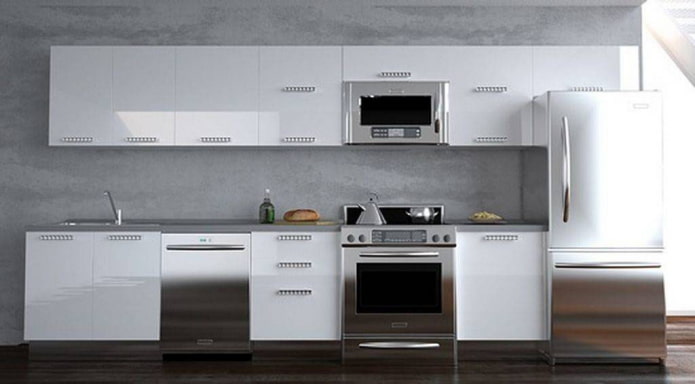
Does brand affect quality?
The brand of the dishwasher is an important factor that affects the service life of the equipment. It has long been proven that some manufacturers produce higher quality goods. Thanks to a robust design and high-quality parts, such dishwashers last longer. To simplify the task of choosing and minimize possible options, we have compiled a list of the best modern models based on reviews and comments from Russian users. This will help you choose a dishwasher.
The best brands: Weissgauff, Bosch, Beko, Candy, Kuppersberg, Electrolux, Gorenje, Indesit.
The Bosch brand produces dishwashers in different price segments from budget to expensive.
In the premium segment, models with inverter motors have a good rating:
- Bosch SMV25BX04R (4.8).
- Bosch SMS25FW10R (4.7).
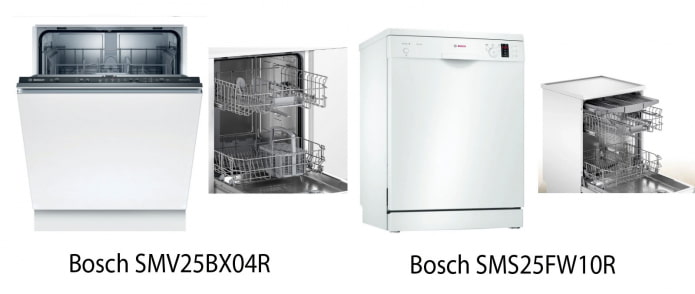
Both models are full-size and suitable for a large family. Here are the reviews users left about them on Yandex.Market.


In the middle segment, the Weissgauff brand holds a leading position. The compact dishwasher Weissgauff TDW 4006 D has a rating of 4.8 and the full-size dishwasher Weissgauff DW 6015 also has a rating of 4.8. Reviews of these models in Yandex.Market.


Full-size dishwashers are in demand and have a good rating in this price category:
- Electrolux ESF 9552 LOX (rating 4.5).
- Gorenje GV631D60 (rating 4.7).
- Indesit DFE 1B10 (rating 4.8).
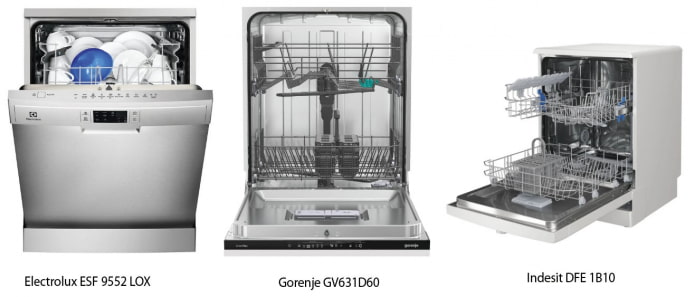
In the economy segment, there are three inexpensive models from different brands. All of them have a rating of 4.7 on Yandex.Market:
- Beko DFS05012W is a narrow model.
- Candy CDCP 8/E-07 is compact.
- Weissgauff TDW 4006 is compact.
See reviews of them below.
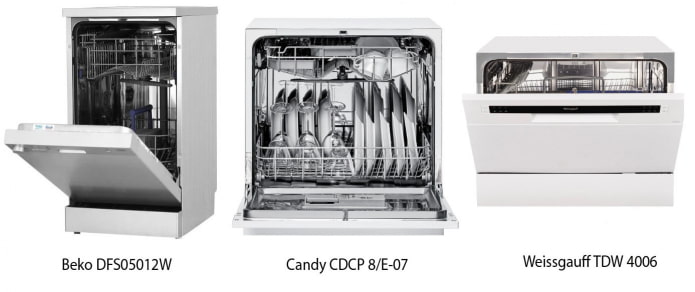


We have considered all the main parameters that need to be taken into account when choosing a dishwasher. We hope that this information will allow you to make the best choice.
Now reading:
- Dynamic Hyundai Veloster: Unleashing Performance and Style
- How to choose a chair? 34 photos in the interior, types and design ideas.
- Hidden Doors in the Interior: 37 Photos and Creative Design Solutions
- Doors for the hallway and corridor: more than 50 photos, fresh solutions for your home
- 60 design ideas: green kitchen units in the interior and photos.